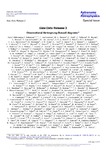Gaia Data Release 2: Observational Hertzsprung-Russell diagrams

Ver/
Use este enlace para citar
http://hdl.handle.net/2183/37239
A non ser que se indique outra cousa, a licenza do ítem descríbese como CC BY Creative Commons Attribution License
Coleccións
- Investigación (FIC) [1724]
Metadatos
Mostrar o rexistro completo do ítemTítulo
Gaia Data Release 2: Observational Hertzsprung-Russell diagramsAutor(es)
Data
2018Cita bibliográfica
Gaia Collaboration, Babusiaux, C., et al. (2018). Observational hertzsprung-russell diagrams. Astronomy and Astrophysics, 616. https://doi.org/10.1051/0004-6361/201832843
Resumo
[Abstract] Context. Gaia Data Release 2 provides high-precision astrometry and three-band photometry for about 1.3 billion sources over the full sky. The precision, accuracy, and homogeneity of both astrometry and photometry are unprecedented.
Aims. We highlight the power of the Gaia DR2 in studying many fine structures of the Hertzsprung-Russell diagram (HRD). Gaia allows us to present many different HRDs, depending in particular on stellar population selections. We do not aim here for completeness in terms of types of stars or stellar evolutionary aspects. Instead, we have chosen several illustrative examples.
Methods. We describe some of the selections that can be made in Gaia DR2 to highlight the main structures of the Gaia HRDs. We select both field and cluster (open and globular) stars, compare the observations with previous classifications and with stellar evolutionary tracks, and we present variations of the Gaia HRD with age, metallicity, and kinematics. Late stages of stellar evolution such as hot subdwarfs, post-AGB stars, planetary nebulae, and white dwarfs are also analysed, as well as low-mass brown dwarf objects.
Results. The Gaia HRDs are unprecedented in both precision and coverage of the various Milky Way stellar populations and stellar evolutionary phases. Many fine structures of the HRDs are presented. The clear split of the white dwarf sequence into hydrogen and helium white dwarfs is presented for the first time in an HRD. The relation between kinematics and the HRD is nicely illustrated. Two different populations in a classical kinematic selection of the halo are unambiguously identified in the HRD. Membership and mean parameters for a selected list of open clusters are provided. They allow drawing very detailed cluster sequences, highlighting fine structures, and providing extremely precise empirical isochrones that will lead to more insight in stellar physics. Conclusions. Gaia DR2 demonstrates the potential of combining precise astrometry and photometry for large samples for studies in stellar evolution and stellar population and opens an entire new area for HRD-based studies.
Palabras chave
Parallaxes
Hertzsprung-Russell and C-M diagrams
Solar neighborhood
Stars, evolution
Hertzsprung-Russell and C-M diagrams
Solar neighborhood
Stars, evolution
Versión do editor
Dereitos
CC BY Creative Commons Attribution License






